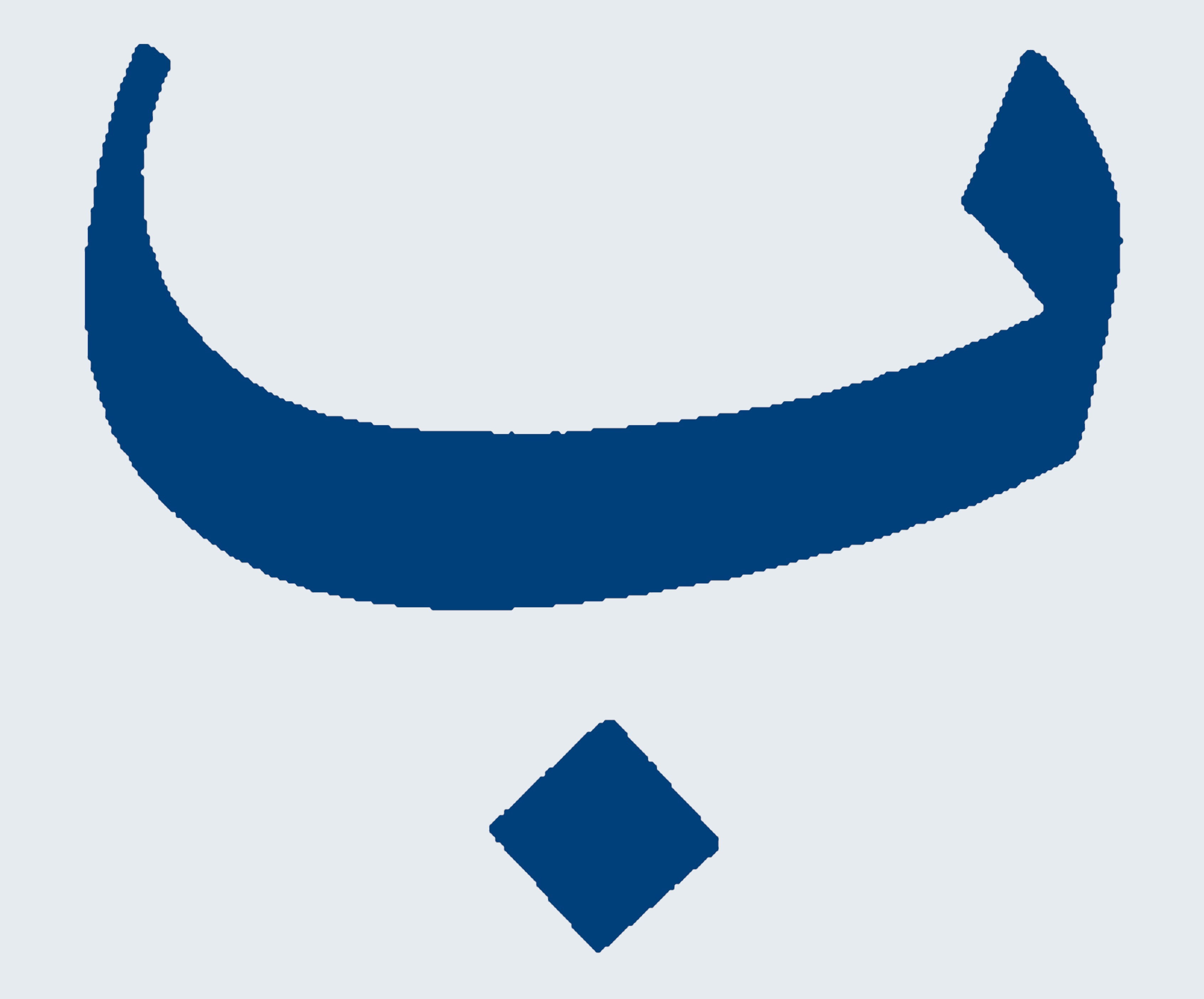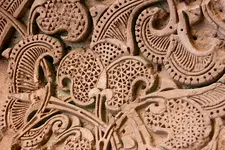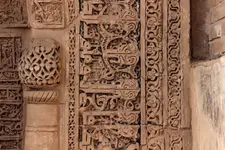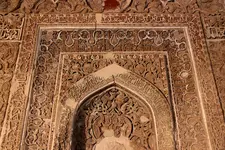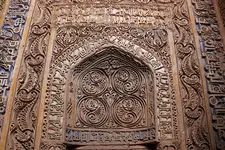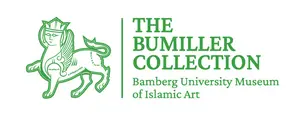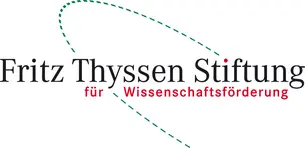Programme change notifications!
Please note the following changes in programme of May 5th:
- Paper by Barbara Finster has been cancelled
- Paper by Sheila Blair will be delivered at 16:30 instead of 17:30 o’clock (German time)
Stucco in the Architecture of Iran and Neighbouring Lands: New Research – New Horizons
A conference hosted by the University of Bamberg Islamic Art and Archaeology, Institute of Oriental Studies
Venue: Schillerplatz 17, 96049 Bamberg
Wed 4 May 2022 Location: Dominican Library Hall, Kasernstraße 4, 96049 Bamberg
18:00
Welcome Addresses by the Dean of the Faculty of Humanities and the Director of the Oriental Institute of the University of Bamberg, and the Mayor of the City of Bamberg | |
Keynote Speech: Stucco in Iran. Reviving faded colours through art history (Lorenz Korn) | |
Refreshments | |
Thu 5 May 2022 Location: Institute of Oriental Studies, Schillerplatz 17, 96049 Bamberg, Room 00.13
09:00 | Conference Registration | |
09:30 | Lorenz Korn: Opening Remarks | |
10:00-12:00 | Panel 1: Research of Persianate Stuccos: Past, Present and Future | |
Chair: Lorenz Korn | ||
Renata Holod | Recovering Rayy: Erich Schmidt’s Excavations at Rayy, Iran, and their Contribution to the Study of the Material Culture of Medieval Iran | |
Claus-Peter Haase | From Iran to “The Western Boundaries” or vice versa: Possible trends in the development of early Islamic stucco motives and structures | |
Robert Hillenbrand | Iranian Saljuq Stucco in Anatolia | |
Yves Porter and Anais Leone | Stucco vs Luster in Ilkhanid Iran | |
12:00 | Lunch Break | |
13:30-15:30 | Panel 2: Pre-Islamic to Saljuq Periods | |
Chair: Ana Marija Grbanovic | ||
Meysam Labbaf-Khaniki and Atefeh Shekofteh | Identification and Technical Examination of the Stucco Decorations from Bazeh-Hur in North-Eastern Iran | |
Niloufar Ehteshami | Continuity or Discontinuity in Stucco Motifs from Sasanian to the Early-Islamic periods: Finds from the Jahangir and Gowriyeh Sites in Ilam, Iran | |
Maryam Moeini | Some Little-known pre-Ilkhanid Architectural Revetments from the Friday Mosque of Tabriz | |
Iman Aghajani | Innovations in Stucco Decoration during the Seljuq Period in Iran | |
15:30 | Coffee Break | |
16:00-18:00 | Panel 3: Western Boundaries | |
Chair: Claus-Peter Haase | ||
Andrea Luigi Corsi | Beyond the ‘Samarra Styles’: Reconsidering the 10th-century Stuccowork in Deir al-Surian as a Reflection of Post-Samarra Mesopotamian Stucco Production | |
Bernard O’Kane | Mamluk Stuccos - the Iranian Connection? | |
Sheila Blair (on-line) | Stucco Workers, Luster Potters and Builders: The case of Hasan ibn ʿAli ibn Ahmad ibn Babawayh al-Vidguli | |
18:30 | Reception at the University of Bamberg Museum of Islamic Art (the Bumiller Collection), welcome by Verena Daiber (Curator) | |
Fri 6 May 2022 Location: Institute of Oriental Studies, Schillerplatz 17, 96049 Bamberg, Room 00.13
09:00-10:30 | Panel 4: Ilkhanid Stuccos | |
Chair: Iman Aghajani | ||
Ana Marija Grbanovic | Uljaytu’s Mausoleum at Sultaniyya and its Architectural Revetments (North-western Iran, 1305-1316/20) | |
Bahareh Taghavinejad (on-line) | Some Pieces of Evidence of the Personal Style of Damghani Artists in the Stucco Decorations of the Ceiling of Soffe-ye Darvish in Isfahan Grand Mosque | |
Elaheh Alvandiyan (on-line) | Introduction and Recognition of Stucco Technique of the Tomb of Seyyed Roknuddin Yazd | |
10:30 | Coffee Break | |
11:00-13:00 | Panel 5: Techniques and Archaeometry | |
Chair: Lorenz Korn | ||
Amir Hossein Karimy AND Parviz Holakooei (on-line) | Blue ‘Out of the Blue’: Scientific Studies on the Blue Pigments Applied on Persian Stuccos | |
Moslem Mishmastnehi and Tomasz Stawski | Crystals of Gypsum in Hands of Masters: Interdisciplinary approach to understand the chaîne opératoire of Seljuk and Ilkhanid Stuccoes | |
Marco Brambilla | Pre-fabricated Stucco Decorations in Sultaniyya | |
Stefan Masarovic | Material Examination of Five Seljuk and Muzafarrid Carved Architectural Decoration Stucco Segments: Three monumental figurative panels and two further objects preserved at the Museum of Islamic Art in Doha | |
13:00 | Lunch Break | |
14:30-16:30 | Panel 6: Eastern Boundaries | |
Chair: Moslem Mishmastnehi | ||
Viola Allegranzi and Sandra Aube | The Noh Gonbad Mosque in Balkh: New insights into its stucco decoration | |
Ruslan Muradov (on-line) | Restoration of the Mihrab of the Mashhad-Ata Mosque in Medieval Dahistan | |
Richard McClary and Ahmad Yengimolki | The Qarakhanid Stucco Decoration in the Shah Fazil Tomb at Safid Buland, Kyrgyzstan: A Unicum in Context | |
Valentina Laviola | Ghazni Stuccoes. From an Old Excavation to a Synergic Study of the Architectural Decoration of the Ghaznavid Palace | |
16:30 | Coffee Break | |
17:00-18:30 | Panel 7: New Ideas and Approaches | |
Chair: Marco Brambilla | ||
Ruba Kanaan (on-line) | Matter, Mode, and Making: Stucco in the legal texts of Iran and Central Asia (11th-13th c.) | |
Katherine Hughes | The Fabric of the Building: The ecology of Samanid stucco ornament and non-representational haptic space | |
Giuseppe Labisi (on-line) | Stucco Decoration in Semi-Domes Squinches. Sasanian Architectural Heritage within Early Islamic Architecture | |
19:00 | Speakers’ Dinner, “Efendi” Restaurant | |
Sat 7 May 2022 Location: Institute of Oriental Studies, Schillerplatz 17, 96049 Bamberg, Room 00.13
09:30-11:30 | Panel 8: Conservation and Preservation of Stuccos | |
Chair: Sandra Aube | ||
Rosario Paone | Esfahan, IsMEO Restorations of Stucco and Plaster in the Seventies | |
Hamed Sayyadshahri and Mohammad Mortazavi | Reconstruction of Missing Parts of the Stucco Decorations: Some Restoration Experiences | |
Yaser Hamzavi | The Contemporary Challenge for Conservators to Preserve Creative Stuccoes from the Past: Molded stucco of the tomb of Sayyid Rukn al-Din and Sayyid Shams al-Din in Yazd | |
Majid Montazer Zohouri and Iman Aghajani | Archaeological Studies on Islamic Stucco Decorations in the Storage of National Museum of Iran | |
11:30 | Coffee Break | |
12:00 | Final Discussion and Closing Remarks | |
13:00 | Lunch Break | |
In the afternoon: Visit to the Schönborn prince-bishop residence of Pommersfelden 19:00 Opportunity for dinner at the historical Klosterbräu brewery in Bamberg | ||
Stucco, as one of the most widespread media of decoration throughout the history of architecture, has received increasing interest over the last few years. Before, stucco in the eastern Islamic sphere was studied sporadically, and its scholarly perception has been impacted by numerous disciplinary and methodological divides. The division between research on the pre-Islamic and Islamic periods implied that pre-Islamic stuccos were considered as products of a separate period, or at best as forerunners of a technology of architectural decoration that fully flourished in Islamic times. The wider interest in early Islamic stuccos was frequently limited to objects from the Abbasid caliphal residence of Raqqa or Samarra, whereas early stuccos from other regions remained little known, or were viewed as the mostly dependant from the Mesopotamian sites. However, a recent series of research projects in stucco decorations has begun to change the situation. As materials from older fieldwork are being re- examined and new materials are appearing (e.g. from the excavations at Balkh and Ghazni), new questions have been raised. Accompanied by some revised attributions and re-groupings, the new interest in stucco is apt to open a wider field of aesthetics that connects architecture with the arts of the object, and in which established boundaries are being questioned. For example, the Mongol invasion to Persia from 1220 onwards, commonly understood as causing a major break in the history of Islamic Art, appears as a moment of transition when looking at the forms, techniques of stucco decoration.
In the traditional approach by Historians of Islamic Art, stucco decoration was assessed by its style – the characteristics of visual appearance and ornamental iconography. Stuccos have been viewed as works of different regional schools, and in parallel, differences in their production methods, more exact dating or detailed observations of their craftsmanship, which could lead to more comprehensive understanding, have been overlooked. Over the last few years, aspects of production technology have received more attention. For example, it seems now generally accepted that the majority of Islamic stuccos were originally brightly coloured, even if this is rarely addressed. However, researchers are only beginning to find out what techniques the craftsmen exactly used, and how the stuccos actually looked in their intended colouring.
Perception of stucco as a craft, rather than art, and the near-absence of stucco from museum collections, had rendered it a subject less worthy of discussion. Access to monuments and stuccos in the Middle East is sometimes challenging, particularly for international researchers. More recently, the subject has seen a revived interest, by the means of thorough monument documentation and their art historic discussion. Preliminary archaeometric research for material characterization of the stucco body and of colouring, and a better understanding of their production have begun to emerge. Two recent conferences on stucco in the Islamic world, held at the University of Kashan in April 2017 and organized by the Institute of Iranian Studies of the Austrian Academy of Sciences (online) in January 2021, have been indicative of this development.
In order to contribute to the field, a research group in Islamic Art and Archaeology at the University of Bamberg is conducting a DFG-funded project, dedicated to art historical and archaeometric aspects of 11-14th century stuccos in Iran. We decided to organize a conference dedicated to the subject, in order to generate further scholarly interaction and to communicate the latest research finds and innovative methodology for research of stuccos. Traditional disciplinary confines will be transcended by inclusion of experts from different fields into the conference. Furthermore, dynastic, temporary and geographical boundaries will be tackled. The edited volume, based on the papers presented at the conference, is intended to disseminate these research finds to the wider scholarly audience of, not only, the field of Islamic Art and Archaeology, but also for disciplines such as History, Sociology, Anthropology and Cultural Heritage Preservation.
